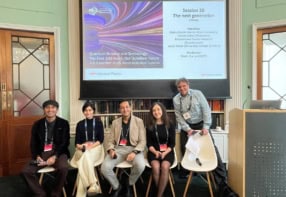Steven Hall revisits the huge changes in journals publishing over the past 30 years

When I looked back at the second issue of Physics World, which appeared in November 1988, I was amused to spot a note in which the then editorial director of IOP Publishing expressed relief that a UK postal strike had slowed the rate of submissions to its 17 journals. The company was on track to receive almost 5500 submissions in 1988, an increase of 15% on 1987, but the threatened delays had been alleviated by “the use of telex, fax and electronic mail”. Three decades on, submissions to the 50 journals now managed editorially by IOP Publishing are on track to exceed 44,000 – an increase of (yes, you’ve guessed it) 15% on the previous year. Plus ça change…
In the December 1988 issue of the magazine, the editorial director then reported that the company would formally take manuscripts in electronic form (TEX only), on floppy disc, from the following month, though only after a printed version of the paper had been accepted. The aim was to reduce production times, not to speed up peer review, but it was one of the first signs of the transition from print to digital in journals publishing. It would, however, be a few more years before publishers didn’t just accept material electronically, but also started delivering journals to libraries and their readers in that form too.
Publishing pioneer
Some publishers – I worked at one at the time – had begun to publish bibliographic and full-text databases on CD-ROM in the late 1980s. But journal publishers were a conservative bunch (some perhaps still are) and it wasn’t until the mid-1990s that digital delivery took off, encouraged by the 1996 UK Pilot Site Licence Initiative. It granted UK universities online access to electronic journal collections from four publishers, including IOP Publishing, which had been at the forefront of online developments. In 1994 we had been the first physics publisher to launch a journal on the Internet, Classical and Quantum Gravity, and all our journals became available online in January 1996.
The advent of the Web, and the ability to deliver publications online to libraries and their users, has profoundly shifted how we interact with our customers, whether authors, reviewers, editors, librarians or readers. Publishers have moved from being producers of physical artefacts – printed journals, CD-ROMs and hard-copy books – to suppliers of digital services. It’s a cultural change that is still ongoing.
I don’t have the data to tell me how quickly IOP Publishing reviewed and produced an article in 1988, but it was almost certainly far slower than today, despite the far lower volume of submissions back then. These days, IOP Publishing typically takes just 42 days from submission to “first decision” – the decision in principle to publish an article before author revisions – and not much more than 100 days for the entire process from submission to online publication.
It is the move to a largely digital publishing model over the past 30 years that has enabled publishers to speed up the publication process while coping with the enormous growth in submissions and published articles, supported by substantial investments in editorial staff, publishing processes and IT. While all publishers have improved their publication speeds, I believe IOP Publishing is ahead of most, taking into account the quality of our peer review too.
The move to a largely digital publishing model over the past 30 years has enabled publishers to speed up the publication process while coping with the enormous growth in submissions and published articles.
Steven Hall
That transition from print to digital has in turn stimulated two significant changes to the business models for journals publishing. The first has been the move by publishers and their library customers from the sale and purchase of subscriptions to individual journals to the licensing of a publisher’s entire journal portfolio – the so-called “big deal”. This big deal has grown bigger still through the formation of regional, national and even international library consortia to negotiate joint licences with publishers.
Some librarians and administrators accuse publishers of imposing this new model on libraries. But that ignores the fact that it was the Higher Education Funding Council for England – through its Joint Information Systems Committee (now just Jisc) – that introduced the idea of a UK Pilot Site Licence; and that libraries have largely embraced the model, trading some flexibility for the greatest possible access to the research literature.
The second big change has been open-access publishing, which would have been inconceivable before digital publishing. IOP Publishing has been at the forefront of this endeavour too, having launched its first open-access journal – New Journal of Physics – in partnership with the German Physical Society in 1998. Open-access publication is now an integral (if not yet dominant) part of scholarly publishing, allowing the final version of an article to be made freely accessible immediately on publication under a licence that allows almost unlimited reuse.

Co-ordinated action required to boost ‘open-science’ initiatives
A report published at the end of 2017 by Universities UK – Monitoring the Transition to Open Access – estimated that 19% of all journal articles were published on an open-access basis in 2016, with the figure for articles by UK authors at 30%. Some national consortia, for example in Germany and the Netherlands, are now seeking to combine the big deal with open access, by flipping the business model from one under which they pay for access to the journals to one under which they pay for all articles by their researchers to be published on an open-access basis, with access to all other articles at no or minimal additional cost.
Into the future
I doubt if those conservative journal publishers of the late 1980s could have foreseen such a development, which is why I’m going to forbear any crystal-ball gazing on the state of scientific publishing in 2048. All I can predict is that it’s likely to change as much or more in the next 30 years as in the past 30, and all I can hope is that learned-society publishers, like IOP Publishing, can continue to adapt, and thereby support their parent organizations, as they do today.



